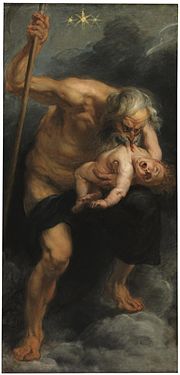**********QUOTE********
http://en.wikipedia.org/wiki/Saturn_Devouring_His_Son
Saturn Devouring His Son is the name given to a painting by Spanish artist Francisco Goya. It depicts the Greek myth of Cronus (in the title Romanised to Saturn), who, fearing that his children would supplant him, ate each one upon their birth. It is one of the series of Black Paintings that Goya painted directly onto the walls of his house sometime between 1819 and 1823.
After Goya's death the work was transferred to canvas, and now resides in the Museo del Prado in Madrid.
Saturn Devouring His Son, a disturbing portrait of the god Saturn consuming one of his children, was one of six works with which Goya decorated the dining room. According to Roman myth, it had been foretold that one of the sons of Saturn would overthrow him, just as he had overthrown his father, Caelus. To prevent this coming to pass, Saturn would eat each of his children as soon as they were born. His wife Ops eventually hid his sixth son, Jupiter, on the island of Crete, deceiving Saturn by offering a stone wrapped in swaddling in his place. Just as the prophecy had predicted, Jupiter eventually supplanted his father.
Goya never named the works he produced at Quinta del Sordo; the names were assigned by others after his death,<2> and this painting is also known as just Saturn, Saturn Devouring One of His Sons, Saturn Devouring his Children or by the Spanish names Saturno devorando a su hijo or Saturno devorando a un hijo. Goya scholar Fred Licht has raised doubts regarding the traditional title, noting that the classical iconographical attributes associated with Saturn are absent from the painting, and the body of the smaller figure does not resemble that of an infant.<3>

Goya may have been inspired by Peter Paul Rubens' 1636 picture of the same name. Rubens' painting, also held at the Museo del Prado, is a brighter, more conventional treatment of the myth: his Saturn exhibits none of the cannibalistic ferocity portrayed in Goya's rendition. However, some critics have suggested that Rubens' portrayal is the more horrific: the god is portrayed as a calculating remorseless killer, who fearing for his own position of power murders his innocent child. Goya's vision, on the other hand, shows a man driven mad by the act of killing his own son. In addition, the body of the son in Goya's picture is that of an adult, not the helpless baby depicted by Rubens. Goya had produced a chalk drawing of the same subject in 1796-7 that was closer in tone to Rubens' work: it showed a Saturn similar in appearance to that of Rubens', daintily biting on the leg of one of his sons while he holds another like a leg of chicken, with none of the gore or madness of the later work.
********UNQUOTE********